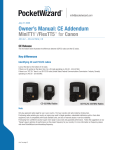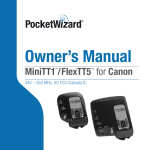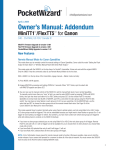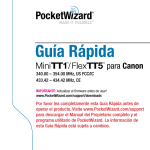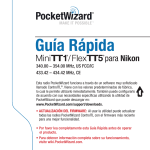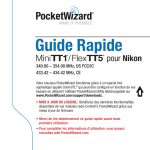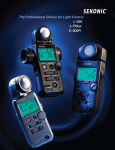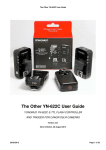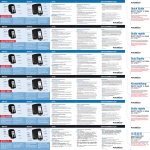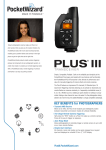Download MiniTT1
Transcript
[email protected] December 29, 2009 Owner’s Manual: Addendum 5.0 MiniTT1 / FlexTT5 for Canon TM TM MiniTT1 Firmware Upgrade to version 5.000 FlexTT5 Firmware Upgrade to version 5.000 PocketWizard Utility Upgrade to version 1.18.9 340.00 - 354.00 MHz, FCC/IC 433.42 - 434.42 MHz, CE Overview ControlTLtm Firmware Version 5.0 is the most advanced firmware for the MiniTT1 Transmitter and FlexTT5 Transceiver. This newest ControlTL firmware incorporates several new features, many performance improvements and some new camera and flash compatibility. This firmware has been tested via the PocketWizard Beta Lab. Current MiniTT1 Transmitter and FlexTT5 Transciever owners can upgrade to the new firmware for free via the PocketWizard Utility. Current users will need to upgrade their PocketWizard Utility to version 1.18.9, which is also on the downloads page. Please see a list of changes to the new Utility at the end of this document. When upgrading your radios, be sure to upgrade all MiniTT1’s and FlexTT5’s to v5.0. Radios will only operate as expected when all units are using the latest firmware. Compatibility Added Canon 7D compatibility. Like the 5D Mark II and other cameras, adjusting Speedlites via the in-camera menu is not supported. Added Metz 58 AF-1 Canon (firmware v3.0) and Metz 48 AF-1 Canon (firmware v2.0) compatibility. These flashes now work with the ControlTL system. Key New Features Automatic Camera Detection: Camera model detection is now truly automatic. This feature obsoletes the need to select your camera model via the PocketWizard Utility. This gives you optimized High Speed Sync straight out of the box. On the Misc Tab, leave your camera model set to Auto (default) to use this feature. If you select your camera model, you will get the exact same features as with Auto, but you will not be able to switch your MiniTT1 or FlexTT5 radio to another camera model without first selecting it in the Utility. Always turn OFF your radio when switching cameras even if they are the same model. www.PocketWizard.com [email protected] 2 Optimized HSS Crossover Auto Detect: We changed the optimized HSS crossover point to automatically detect based on camera type. This allows the 5D and the 5D Mark II to sync at all shutter speeds with Canon Speedlites right out of the box without needing to use the PocketWizard Utility. “High Speed Sync (FP Flash Sync) Begins At” will automatically be set to 1/320 for the 5D and 5D Mark II, and 1/400 for all other camera models. This feature is automatically engaged by default, or can be set by selecting “Auto” for “High Speed Sync (FP Flash Sync) Begins At” in the PocketWizard Utility. Selecting a different HSS crossover point overrides the auto setting. Rear Curtain Sync: We’ve added Rear Curtain Sync capabilities with the ability for you to set the shutter speed at which rear curtain sync is engaged. The default setting is set at 1/100 second so any time you are at that shutter speed or slower, rear curtain sync will be engaged. You can adjust this setting (or turn it off) in the PocketWizard Utility under the “Sync Timing” tab. We found in testing that the Canon system rear curtain sync timing is actually not at the precise end of the shutter opening, but actually slightly before (Fig 1). We have been able to improve on this timing to put the flash at the very end of the exposure (Fig 2). Fig 1: Rear Curtain Sync using Canon’s technology. Note: streak below golf ball. Camera: 7D; Shutter Speed: 1/10th; Aperture: f/5.6; Lens: EF 50mm f/2.5 Macro Fig 2: Rear Curtain Sync using PocketWizard’s technology. Camera: 7D; Shutter Speed: 1/10th; Aperture: f/5.6; Lens: EF 50mm f/2.5 Macro You do not need to set anything on your flashes including Canon’s own Second-Curtain Sync button. Toggling the setting on the flash will not change the setting in the radio. www.PocketWizard.com [email protected] 3 Pre-Flash Boost Mode: In certain E-TTL situations, especially when shooting in full sun or over long distances, the normal pre-flash is simply not enough for the camera to see. Now, when Pre-Flash Boost is engaged, you get a pre-flash that is two stops brighter. This will approximately double the distance that the camera can make sense of the pre-flash E-TTL information or help compensate for the reduced output caused by a diffuser over the flash or a bounced flash. Pre-Flash Boost can be engaged for your on-camera flash by simply angling the flash head in any direction other than the standard 90º position. Pre-Flash Boost is engaged on a remote FlexTT5 by default, regardless of flash head position. The PocketWizard Utility allows you to set Pre-Flash Boost modes independently for a local/on-camera flash or a remote flash. This is done on the Flash Tab. “Local Preflash Boost Mode” is for a flash mounted on the MiniTT1 or FlexTT5 when it is used as a transmitter on the camera. “Remote Preflash Boost Mode” is for a flash mounted on the FlexTT5 when used as a remote receiver. Setting this mode on a FlexTT5 used as a transmitter will not engage Pre-Flash Boost for other FlexTT5 radios used as remote receivers. It must be set on each remote FlexTT5 individually. - “Force Preflash Boost” turns Pre-Flash Boosts on full-time (helpful when using diffusers). This is the default setting for a remote FlexTT5. - “Auto Preflash Boost” enables Pre-Flash Boost whenever the flash head is rotated in any direction other than the standard 90º position. In the standard 90º flash head position, Pre-Flash Boost will not be used. This is the default setting for a MiniTT1 or FlexTT5 used as a transmitter. - “Disable Preflash Boost” turns Pre-Flash Boost off. Pre-Flash Boost is compatible with the following Speedlites only: 580EX, 580EX II, 430EX, 430EX II, 270EX Pre-Flash Boost is not compatible with the following Speedlites and will be automatically disabled: 220EX, 550EX, 420EX It is also not compatible with the Metz 58 AF-1 or 48 AF-1 Canon. When using these flashes you must manually set both Pre-Flash Boost modes to “Disable Preflash Boost” in the Utility. Other New Features - FEC (Flash Exposure Compensation) can now be set directly on a Speedlite in the shoe of a remote FlexTT5. - Continuous triggering added for bottom shoe input when in Basic Trigger Mode. This allows you to trigger a remote camera for a continuous motor drive burst. Connect a footswitch or other button via the transmitting MiniTT1 or FlexTT5 radio’s hot shoe to use this mode. - Test button on FlexTT5 Transmitter starts local relay sequence on camera motor drive allowing you to easily test your relay set-up. www.PocketWizard.com [email protected] 4 - Depth of Field preview remote activation added. When you press the DOF preview button on your camera, your remote flashes will activate their DOF preview mode normally. - Remote camera pre-trigger/wakeup control from a MultiMAX Transceiver – This allows you to remotely wake-up or sleep your remote camera when it’s connected to a FlexTT5 by simply toggling its Zone on a transmitting MultiMAX. Requires an -ACC motor drive cable. Works in Basic Trigger Mode or when receiving on a Quad-Triggering Standard Channel (un-check “Use ControlTL for Rx Channel” on the Channel tab). Not available on ControlTL channels. Bug Fixes / Refinements - Force Master Mode with a 430EX II has been improved on the Rebel XSi, and possibly other cameras, when triggering a MiniTT1. Corrects an issue where a full power flash (blowout) would occur on occasion. - Remote Wireless Manual Power Control will now permit maximum output power on all flashes when used in X-Sync mode (HSS mode was not an issue). - Corrected a situation where pressing TEST on a FlexTT5 made it so you could not trigger for 2 or 3 seconds, but only on a Standard Channel. - Flash Exposure Lock (FEL) with 5D Mark II has been improved. Corrected a situation where pressing FEL would cause a remote flash to trigger and/or blowouts would occur. - Improved continuous remote camera triggering operation for the following scenario: FlexTT5 connected to a camera’s motor drive port with an -ACC cable and set to a Standard channel and Bottom Shoe Disable mode turned on. - Improved 50D performance by eliminating an issue with blowouts occurring with on-camera flash set to Master Mode or when using Force TTL Master Mode. - Corrected 420EX flash periodic random exposure blowouts when used as remote flash on a FlexTT5. - Improved battery monitoring for MiniTT1 Transmitter. - Power management changes to reduce risk of battery leakage on FlexTT5 when used with alkaline batteries. The MiniTT1 coin cell is less likely to leak based on its chemistry. - Corrected 1D Mark III with on-camera flash which had periodic blowouts if put in 10 fps high speed drive mode. - Corrected a relay mode lock-up issue (camera would trigger continuously) which occurred when TEST was pressed on the remote FlexTT5 in Basic Trigger Mode. - Corrected possibility of random blowouts if pre-flash RF command was missed by FlexTT5. - Fixed problems with Bottom Shoe Disable mode where bottom shoe was still responding to shoe data which could cause a remote camera to not trigger. - Corrected issue where Canon 1D Mark II or 1D Mark IIn would not trigger from CM-N3-ACC cord. - Corrected issue where 430EX II would appear to switch out of SLAVE mode automatically as the FlexTT5 was turned on, but did not do so properly and would then not trigger correctly. Switching out of SLAVE mode is the correct behavior as Canon SLAVE mode is not used for remote ControlTL flashes. www.PocketWizard.com [email protected] 5 - With previous versions of the firmware, using a 5D Mark II with fast aperture lenses imposed a limitation on the narrowest aperture you could use. This issue has been eliminated completely and all apertures should be available with this camera, regardless of the lens used. - The issue regarding white balance color shifting occasionally at HSS shutter speeds when using a FlexTT5 as a Transmitter on a camera has been fixed. PocketWizard Utility 1.18.9 New Features: - Added Beta functionality: the public Beta Lab will be used to post beta versions of firmware for PocketWizard radios. Users will be able to download the beta vesion from the beta lab and provide feedback before we release new firmware to the public. - Added a Settings button to allow control of automatic downloads and provide access to Beta Lab. - Made downloads faster for multiple units (download once, update many). Also added a “Download All” feature. - Added a Device Inventory feature under the Settings button. - Added Mac Snow Leopard compatibility. Bug Fixes / Refinements: - Corrected an issue where buttons were “graying out” making the Utility unusable. This was done by improving the FTP operation. Additional Notes: - You will notice new features in the PocketWizard Utility which have been added as part of a future direction for ControlTL features. The Modeling and Exposure Tabs and some items on the Flash Tab do not apply to your MiniTT1 or FlexTT5 ControlTL radios. - The PocketWizard Utility Help files are currently being re-written to sync with current product features and updates. New Help files will be availalble for download in the near future. All information on how to access the new features of ControlTL firmware 5.0 via the PocketWizard Utility have been communicated in this and previous documents. www.PocketWizard.com [email protected] July 27, 2009 Owner’s Manual: CE Addendum MiniTT1™/FlexTT5™ for Canon 433.42 - 434.42 MHz, CE CE Release The information below illustrates the differences between US/FCC radios and the CE radios. Key differences Identifying CE and FCC/IC radios Look at the label on the bottom of the radio. If there is a CE symbol on the label, then it is a CE radio operating on 433.42 - 434.42 MHz If there is an “FCC ID:” then it is a US FCC/IC radio (United States Federal Communications Commission / Industry Canada) operating on 340.00 - 354.00 MHz. CE 433 MHz Radios US FCC/IC 344 MHz Radios Note: Only buy approved radios legal for use in your country. Find your country and radio model by clicking here. Purchasing radios outside your country or region may result in illegal operation, undesirable interference with or from other equipment, lack of compatibility with locally available units, and loss of warranty status or service availability. Purchasing from a different country to gain more range in yours does not guarantee performance. Follow the suggestions on our “Range” page to optimize for performance on the proper frequency for your country. For more information on frequency, please visit www.PocketWizard.com/wheretobuy/frequency. (con’t on page 2) [email protected] 2 Channels CE versions of the ControlTL™ radios use a different set of channels than US FCC/IC radios. A MiniTT1 transmitter or a FlexTT5 transceiver transmits on a Standard channel and a ControlTL channel when triggered. If working around other photographers using PocketWizard’s, make sure you choose a set of channels / frequencies that will not interfere with or trigger other PocketWizard users. CE ControlTL channels 1 - 3 are repeated when teaching with a Standard transmitter like the MultiMAX or a Legacy PocketWizard on all Standard channels. See the MiniTT1/FlexTT5 Owner’s Manual for more information on LEARN Mode and how teaching a Standard channel also teaches a ControlTL channel. That means if you teach a MiniTT1 or FlexTT5 channel 4 from another PocketWizard, it will trigger other Control radios listening on ControlTL channel 1. ControlTL Channel ControlTL Frequency Standard Channel Standard Frequency 1 433.42 1 433.62 2 434.42 2 433.62 3 433.92 3 433.62 1 433.42 4 433.62 2 434.42 5 433.62 3 433.92 6 433.62 1 433.42 7 433.62 2 434.42 8 433.62 3 433.92 9 433.62 1 433.42 10 433.62 2 434.42 11 433.62 3 433.92 12 433.62 1 433.42 13 433.62 2 434.42 14 433.62 3 433.92 15 433.62 1 433.42 16 433.62 1 433.42 17 434.22 2 434.42 18 434.22 3 433.92 19 434.22 1 433.42 20 434.22 2 433.42 21 434.22 3 434.42 22 434.22 1 433.92 23 434.22 2 433.42 24 434.22 3 433.42 25 434.22 1 434.42 26 434.22 2 433.92 27 434.22 3 433.42 28 434.22 1 433.42 29 434.22 2 434.42 30 434.22 3 433.92 31 434.22 1 433.42 32 434.22 www.PocketWizard.com [email protected] July 10, 2009 Owner’s Manual: Addendum v4.300 MiniTT1™/FlexTT5™ for Canon 340.00 - 354.00 MHz, US FCC/Canada IC MiniTT1 Firmware Upgrade to version 4.300 FlexTT5 Firmware Upgrade to version 4.300 All MiniTT1 and FlexTT5 owners are encouraged to upgrade and try this new firmware. Check www.PocketWizard.com regularly for future updates. This new version of the ControlTL firmware introduces many improvements, especially to 5D Mark II operation, as well as corrections and improvements for other camera models. While greatly improved, operation with the 5D Mark II is still not 100%. Notably, operation with wide aperture lenses like the f:2.5 or wider series have some limitations regarding the narrowest aperture that can be used especially when there is a flash used on camera. See below for more details on this specific case. IMPORTANT: • This firmware version requires PocketWizard Utility version 1.18 or later to be installed. If you are still running version 1.15, click here to get the latest version. Find the version number in the title bar of the Utility. • Upgrade all of your MiniTT1 or FlexTT5 radios to the latest firmware. Mixing old and new revisions may result in undesirable behavior. • Always perform a factory reset after updating your firmware. Be sure to write down any custom settings for Configuration 1 or Configuration 2 before you reset your radios so you can re-apply them after the upgrade. See RESET B on page 28 in the Owner’s Manual or simply hold TEST as you power on for 10 seconds until you see 4 blinks (green). New Features Camera model “Auto” setting now detects 5D Mark II The 5D Mark II now gets the benefit of automatic detection when the MiniTT1 or FlexTT5 are used on top of the camera. Previously this camera model had to be selected in the PocketWizard Utility on the Misc Tab for proper timings to be used. Now, due to the unique signature this camera presents to the ControlTL system, the default setting of Auto can be used. Photographers that previously had to craft C.1 or C.2 settings precisely for the 5D Mark II now have more flexibility. Additionally, the uniqueness of the 5D Mark II detection allows for the ControlTL radios to automatically use the higher efficiency High Speed Sync (HSS) flash timings. As announced in firmware version 4.250, these new timings allow for faster recycling, more flashes from your batteries, more light output, and greater working distances than possible when using Canon’s E-TTL system alone. These special timings are available for all compatible Canon EOS DSLRs, but only the 5D Mark II gets the benefit of these timings automatically. To get the benefit of these higher HSS efficiencies with all other cameras, you must select your camera model on the Misc Tab in the PocketWizard Utility. See the Additional Notes: New “Auto” behavior below for more information on “Auto.” [email protected] 2 Canon 270EX compatibility This new Canon flash can be used as follows: 270EX: Can be used on the MiniTT1 or FlexTT5 (transmitter or receiver) in ETTL mode. To use this flash on a ControlTL radio mounted on a camera at HSS shutter speeds, you first need to enable HSS mode in the flash. Mount the 270EX directly on a camera (no radio in-between) and enable HSS mode via the camera’s menus. Once that mode is enabled, the flash will work properly at HSS shutter speeds when mounted on a MiniTT1 or FlexTT5 when used as a transmitter. HSS operation is automatic (no need to set it) when used on a FlexTT5 as a receiver. This flash may have occasional exposure issues when used on a MiniTT1 or FlexTT5 mounted directly on certain cameras like the 5D Mark II, 40D, 20D, and possibly others. ADDITIONAL NOTES: New “Auto” behavior: Calibration shot no longer triggers local flashes, specifically selected cameras get calibration shots When the MiniTT1 or FlexTT5 have their camera model set to “Auto” on the Misc Tab in the PocketWizard Utility (default behavior), the first exposure taken after the on-camera radio is powered on is a calibration shot – the radio measures the camera’s pre-sync to X-sync delay. A flash in the top shoe of the camera’s radio will not be fired during this first shot. Previously, flashes were fired during this shot but since the calibration process often yields an unusable image, this was deemed a waste of flash battery power. The new behavior saves flash battery power by not triggering the flash on top during the calibration shot. Remote flashes on FlexTT5 radios will still trigger during this calibration shot. You can avoid this by turning on the remote FlexTT5 radios after you perform your calibration shot. Additionally, when a camera is specifically selected on the Misc Tab in the Utility, the radio still performs a calibration validation measurement on the first shot. Even if you select your camera, the first shot will not trigger a flash in the top shoe of the camera connected radio. This first shot is used to validate that your camera responded in an appropriate time frame to make sure new HSS timings can be used. If it does respond properly, you get the benefits of the new HSS timings. If it does not, then the radio uses Auto mode and default HSS timings. To get your camera to respond properly, and get the most benefit out of “Auto” or a selected camera, take a few shots with it before connecting your ControlTL radio. These few shots are especially helpful if the camera has just come from a temperature extreme (hot from a sunny car trunk, or cold from a plane’s cargo hold) or to lubricate the shutter a few times after having been off for a while. Always trigger at least twice after you turn on your on-camera radio to verify exposure! NOTE: For all cameras, the shutter speed needs to be set to 1/4000 or slower for the first trigger after a ControlTL transmitter is powered on. Calibration measurements cannot be performed at faster shutter speeds. New Default: Force TTL Master Mode “Force TTL Master Mode” is now enabled by default. Previously we emulated Canon’s system such that <MASTER> mode must be engaged on the flash on-camera for remote flashes to trigger. This is Canon’s method for controlling the remote flashes from the camera position – toggling <MASTER> on and off toggles the remote flashes on and off. This operation was not intuitive to [email protected] 3 many photographers and generated many questions, so we now engage our ControlTL feature of “Force TTL Master Mode” by default. The on-camera flash now appears to the camera to be in <MASTER> mode all the time. All remote PocketWizard radios on the same channel will trigger. This mode enables the use of a 430EX or 430EX II in the shoe of a ControlTL transmitter as a master to trigger remote flashes. The transmitter tells the camera that <MASTER> mode is active even though that mode is not available or set in the flash. This also benefits the 580EX (I and II) as they will emit fewer communication flashes. This reduces the “flickering pre-flash” that bothers some subjects. All flash controls remain active. If you wish to retain the ability to toggle on and off your remote flashes using the <MASTER> control on your 580EX or 580EX II, you will need to uncheck “Force TTL Master Mode” in the Utility on the Misc Tab (alternate method: set your on-camera radio to an unused channel, like C.2, to have only the local flash fire and not the remotes – make sure the C.2 channel is not in use by another photographer). You only need to change this setting for a radio used as a transmitter on a camera - FlexTT5 radios used for triggering a remote flash do not need this setting changed. When “Force TTL Master Mode” is engaged, toggling <MASTER> on the flash will not toggle on and off remote flashes. When you perform a factory reset after firmware upgrade, this mode will be engaged by default. FlexTT5 Transmitter Only Mode This mode has been greatly improved and is recommended when using a FlexTT5 as a transmitter on the camera. Without this mode enabled, other photographers could trigger your on-camera flash. Bug Fixes: • Occasionally, the camera’s shutter speed would get stuck at X-sync if TEST was pressed and held for a long time (like when triggering a remote motor driven camera). This has been corrected. • The ST-E2 on top of a MiniTT1 on top of a 5D Mark II, 1D Mark III, and possibly other cameras, would lose its settings when coming out of sleep mode. This has been improved. Interesting to note, this behavior happened on a 5D Mark II with an ST-E2 directly in its shoe (no radios involved). This firmware corrects that behavior. • Distance info on 580EX II not updating sometimes. This operation has been improved, but may still exhibit inconsistent behavior. Recommended workaround is to set the flash on the camera’s radio to never sleep (disable Auto Power Off using the correct custom function). • FlexTT5 as a transmitter on a 1D Mark III had inconsistent performance when adjusting ratios using a flash on top of the Flex. This has been corrected. • 5D Mark II performance with large aperture lenses improved. On wider lenses like the 50mm f/1.4 or 85mm f/1.2 there are still narrower aperture settings that result in shutter clipping. This edited text from the 4.250 Addendum still applies: o Due to special trigger timing considerations for this camera, some lenses will experience frame clipping (hard lines or dark frames caused by the shutter getting “caught” by the flash) at mid to narrower aperture settings. Larger maximum aperture lenses like f/1.4 or f/1.2 models are most affected and may start to see flash clipping as early as f/5.6. Lenses with a widest aperture of f/3.5 to f/5.6 may not experience clipping at all. If there is no flash on top of the ControlTL transmitter in the shoe of the 5D Mark II, results will be better. This aperture issue does not affect any other camera we have tested. Please test each of your lenses across the full range of f-stops to be sure you understand the limitations. [email protected] 4 (more) * = All apertures available for use EF Lens ? = untested (data from beta field reports) Narrowest Aperture No Speedlite on camera’s radio Narrowest Aperture Speedlite on camera’s radio Narrowest Aperture, No Speedlite on camera’s radio HSS shutter speeds Narrowest Aperture Speedlite on camera’s radio HSS shutter speeds EF 50mm f/1.4 f/22* f/8 f/8 f/7.1 EF 50mm f/2.5 Macro f/32* f/14 f/14 f/14 EF 70-300mm f/4-5.6 IS USM f/32* f/32* f/25 f/25 EF 24-70mm f/2.8 L USM f/22* f/14 f/13 f/10 EF 24-105mm f/4 L IS USM f/22* f/22* f/22* f/22* EF 28-135mm f/3.51.6 IS f/22* f/22* f/22* f/22* EF 85mm f/1.8 USM f/22* ? ? ? EF 16-35mm f/2.8 L (II?) USM f/22* ? ? ? EF 135mm f/2 L USM f/29 ? ? ? EF 70-200mm f/4L f/32* ? ? ? USM NOTE: Any Speedlite, including the ST-E2, in any mode when on the camera’s radio can cause this behavior. A fully manual flash, but not a Speedlite even in manual mode, can work. 3rd party E-TTL II compatible flashes have not been tested and may produce undesirable behavior. • FEC control from the flash is now implemented for the FlexTT5 when used as a transmitter. • FEL and FEC operation on a 5D Mark II when using a FlexTT5 on the camera has been improved. • AF-Assist operation greatly improved in several scenarios including on specific cameras like the 5D Mark II and when using the FlexTT5 as a transmitter on the camera. Also corrected a situation where AF-Assist would stay on during the exposure and be visible in the image. • A situation where flash recharge/recycle would be delayed has been corrected. [email protected] 5 • Continuous triggering of a remote FlexTT5, like used for a continuous motor drive burst for a remote camera, was not work ing in Basic Trigger Mode. Also Basic Trigger Mode, when set on a FlexTT5, would only send a single trigger when TEST was held. This would affect both remote camera triggering and teaching a radio a new channel. This has been corrected. • Operation with a 5D Mark II using Master Ratio Mode with a flash or ST-E2 on top has been improved. • Errors with top shoe flash communication after camera wakeup when using a 5D Mark II have been corrected. • Basic Trigger Mode now triggers a flash in the top shoe (and P2 for a FlexTT5) when on a camera. • Fixed a Learn Mode bug in Basic Trigger Mode. If learn mode was engaged during Basic Trigger Mode, but no channel was actually learned, the radio would stop transmitting the previously known channel. This has been corrected. • 5D Mark II operation with an HSS enabled flash on the radio on the camera has been fixed. Not included in this release: • If TEST is pressed on a FlexTT5 in the shoe of a camera, the radio will not allow a Standard trigger from the camera until the STATUS LED blinks twice. This will be corrected in a future release. • If TEST is pressed on a relay FlexTT5 (in the shoe of camera with motor drive cable attached to P1) while in Basic Trigger Mode, the camera gets locked into a continuous trigger. Workaround = test the relay setup using a transmitting PW instead of pressing TEST on the relay radio. Should be corrected in a future release. • G9 and G10 operation no longer supported. A future release may reverse this situation. • On a Rebel XSi, infrequently the camera will revert to 1/200 and then be unable to adjust the shutter speed higher. • On a 20D there may be a slight delay of the local flash trigger at HSS shutter speeds. • On a 5D (not the Mark II) with a 580EX II in the top shoe of a ControlTL radio at fastest HSS shutter speeds, a slight banding can occur at the bottom of the frame. A possible workaround is to use Force TTL Master Mode or use slower shutter speeds. • On a 5D Mark II, and possibly other cameras, a low power test flash can very rarely occur when pressing other camera buttons like FEC. • Remote camera pre-trigger toggle via a MultiMAX on a Standard channel is not implemented at this time. • Features not expressly covered like Rear Curtain Sync, FEB, stroboscopic, remote DOFP and modeling mode, and adjusting flash settings or custom functions via the camera’s menu controls are not yet implemented. • Other manufacturer’s flashes like Quantum, Metz, Sunpak, etc. compatibility is not confirmed. • Custom IDs not yet available. © 2009 LPA Design, Inc. All rights reserved. Product features and specifications are subject to change without notice. PocketWizard, ControlTL, MiniTT1, FlexTT5, HyperSync, Plus II and MultiMAX are either trademarks or registered trademarks of LPA Design, Inc. All other trademarks contained herein are the property of their respective owners. This product is covered under a warranty. For more information on this warranty and to register your product, please go to www.PocketWizard.com/support. US Patent: 5,359,375 and Patents Pending www.PocketWizard.com [email protected] April 28, 2009 Owner’s Manual: Addendum v4.250 MiniTT1™/FlexTT5™ for Canon 340 - 354 MHz, US FCC/Canada IC MiniTT1 Firmware Upgrade to version 4.250 FlexTT5 Firmware Upgrade to version 4.250 CAUTION! • This firmware version requires PocketWizard Utility version 1.18 or later to be installed. If you are still running version 1.15, click here to get the latest version. Find the version number in the title bar of the Utility. • Upgrade all of your MiniTT1 or FlexTT5 radios to the latest firmware. Mixing old and new revisions may result in undesirable behavior. • Always perform a factory reset after updating your firmware. Be sure to write down any custom settings for Configuration 1 or Configuration 2 before you reset your radios so you can re-apply them after the upgrade. See RESET B on page 28 in the Owner’s Manual or simply hold TEST as you power on for 10 seconds until you see 4 green blinks. New Features Higher Efficiency High Speed Sync (FP Flash) Through-the-shoe communications have allowed PocketWizard radios with the new ControlTL™ firmware to significantly boost the performance of the High Speed Sync (HSS) feature of Canon Speedlite flashes. This means more light which equals greater working distance). You also get faster recycling and more flashes per battery set when shooting in Canon’s HSS/FP Flash mode. Because the MiniTT1 Transmitter and FlexTT5 Transceiver communicate through-the-shoe with the camera system in use, they can control the HSS burst duration to match the shutter speed more precisely. This results in large gains in efficiency, as much as 60% in many cases, for both remote and on-camera flashes. This gain in efficiency is immediately translated into shorter recycle time (allowing faster HSS shooting for longer bursts), more shots per battery set, and from 0.5 to 1.8 stops brighter output which enables greater working distance. When using a 580EX II as MASTER for wireless manual, you can expect gains up to 2.3 stops brighter, depending on shutter speed. If you are shooting exclusively at HSS shutter speeds, you will get more than a doubling of battery life from your Speedlite, possibly eliminating the need for an external battery pack. This feature only works with Canon Speedlites at HSS shutter speeds. It will not make your manual hot shoe or studio flashes have more light output at any given setting. Gains when using HyperSync™ are even greater and it is recommended that you use HyperSync for shutter speeds from 1/250 through 1/640 as your camera and flash combo allows. [email protected] 2 IMPORTANT: To get the most benefit from this feature, be sure to select your camera model in the PocketWizard Utility on the Misc Tab. If you do not select your camera model then you will still receive some improvements, but not as much as when you select your camera model. This feature is automatic and requires no adjustment other than selecting your camera model. Here are some examples of the efficiencies gained: f-stops R = f-stops Remote = Speedlite on FlexTT5 radio as a remote unit f-stops L = f-stops Local = Speedlite on a MiniTT1 or FlexTT5 radio as a transmitter on the camera For example, the chart below shows that the 1D Mark III camera, when using HSS triggering at 1/1000 shutter speed, will get 1.4 stops more light from the flash on top of the MiniTT1 in its shoe, and nearly 1.8 more stops from a Speedlite mounted on a remote FlexTT5. * For charts on other cameras, please refer to the end of Addendum v4.250. [email protected] 3 Canon 5D Mark II Compatibility Operation with a Canon 5D Mark II camera has been greatly improved. In addition to HyperSync, remote E-TTL II, and other features already present, you can now use a flash on top of a MiniTT1 or FlexTT5 radio in the shoe of the Canon 5D Mark II. You can now have on-camera flash as well as ratio controls via the 580EX II, 580EX, or ST-E2. Using the 580EX II, you can also use remote wireless manual mode. For the 5D Mark II to function properly with ControlTL radios, you must select “5D Mark II” as the camera model on the Misc Tab in the PocketWizard Utility. SPECIAL NOTE: 5D Mark II Aperture. Due to special trigger timing considerations for this camera, some lenses will experience frame clipping (hard lines or dark frames in the image caused by the shutter getting “caught” by the flash) at mid to narrower aperture settings. Larger maximum aperture lenses like f:1.4 or f:1.2 models are most affected and may start to see flash clipping as early as f:5.6. Lenses with a widest aperture of f:3.5 to f:5.6 may not experience clipping until stopped down to f:22 or narrower. If there is no flash on top of the ControlTL transmitter in the shoe of the 5D Mark II, results will be somewhat better (~1 f-stop narrower will work). This aperture issue does not affect any other camera we have tested. Please test each of your lenses across the full range of f-stops to be sure you understand the limitations. [email protected] 4 Selectable HSS Cross-over Point Using the PocketWizard Utility, you can choose the shutter speed at which High Speed Sync (FP Flash) will start to be used. This allows you to use HyperSync at shutter speeds where it is effective, and then switch to HSS at faster shutter speeds and have seamless high speed triggering with all shutter speeds usable. Once selected, HSS will be used for the selected shutter speed and all faster shutter speeds up to 1/8000. In the PocketWizard Utility on the Sync Timing tab, select the shutter speed where you want HSS to start. For optimum light output, this should be the first shutter speed where you begin to see clipping in the frame that you cannot remove by adjusting HyperSync. If you want to “turn off” HyperSync completely and just use HSS at all faster shutter speeds as if you were using Canon’s optical triggering system, then set this control one shutter speed faster than your camera’s X-sync. You will not receive the extra light output (and working distance and battery life) that HyperSync offers, but then you will also not need to adjust HyperSync. The default is now set to 1/400 since 5D and 5D Mark II users were finding those shutter speeds unusable under the prior method of Auto-HSS crossover at 1/640. ADDITIONAL NOTES: CAUTION! To ensure you do not miss the first shot after the flash on camera sleeps, make sure to set the Custom Function for the flash on camera to Auto Power Off Disable. This applies for all cameras, and any Speedlite used on the MiniTT1 or FlexTT5 as a transmitter. It does not apply to a Speedlite used on a FlexTT5 as a remote flash. A MiniTT1 when used in Basic Trigger Mode must have its TEST button pressed once to trigger remote radios. [email protected] 5 Bug Fixes: • 30D now triggering properly. Previously, this camera would randomly stop triggering a FlexTT5 when used as a transmitter. Additionally, the 30D would not trigger as a remote camera from the FlexTT5. This has been corrected. • 5D Mark II HSS sync failures fixed. • “Remote TTL Flash Sleep Mode” issues resolved. Previously, when set in the Utility, this feature would cause undesired flashing when changing camera settings or when the camera went to sleep or was awakened. This has been corrected. • 1D Mark II ratio mode now functioning properly. Previously this operation required more than 1 shot on a ratio setting for the setting to engage, and sometimes there were over-exposures. This has been corrected. • ST-E2 AF-Assist now works on a 5D, 50D or 40D, and other cameras. Previously the AF-Assist light would not turn on. This has been corrected. • Wide aperture values now registering properly. On lenses that open up to f:1.2 or wider, the aperture values were being handled improperly. This has been corrected. • Fixed a TEST button issue. Previously a TEST button press on MiniTT1 could cause failed triggers for ~5 seconds. In situations where there was a MASTER flash on top of the MiniTT1, TEST was pressed and you tried to take a picture before the MiniTT1 went back to sleep, the exposure would not be correct. This has been fixed. • Basic Trigger Mode battery power management in the MiniTT1 was improved, resulting in slightly longer battery life. • When using the FlexTT5 as a transmitter on a camera, HSS for a flash mounted in the top shoe was not working properly. This has been corrected. • Remote camera triggering via the FlexTT5 has been improved, especially when using “Bottom Shoe Disable Mode.” Use of legacy cables is better supported. Using an -ACC cable is still recommended. • HSS mode was triggering all zones/groups instead of just group A. Now HSS mode honors groups better. • Triggering a remote Speedlite, set for manual flash and triggered by a Plus II or MultiMAX, mounted on a FlexTT5 has been improved. [email protected] 6 Not included in this release: • FEC control from the flash is not implemented for the MiniTT1 and the FlexTT5 when used as a transmitter. FEC from the camera works. Some photographers prefer to use the flash FEC control due to familiarity and simplicity, as well as the ability to achieve +/- 3 stops versus some camera’s +/- 2 stops. • ST-E2 on top of a MiniTT1 on top of a 5D Mark II. The ST-E2 can forget its settings when coming out of sleep mode. • Other features not expressly covered like Rear Curtain Sync, FEB, stroboscopic, remote DOFP and modeling mode, and adjusting flash settings or custom functions via the camera’s controls are not implemented. • Distance info on 580EX II not updating sometimes. • Other flash manufacturer’s flashes. Quantum, Metz, Sunpak, etc. compatibility is not confirmed. • Custom IDs not yet available. [email protected] Additional Graphs for f-stop Gains: 7 [email protected] 8 [email protected] 9 [email protected] © 2009 LPA Design, Inc. All rights reserved. Product features and specifications are subject to change without notice. PocketWizard, ControlTL, MiniTT1, FlexTT5, HyperSync, Plus II and MultiMAX are either trademarks or registered trademarks of LPA Design, Inc. All other trademarks contained herein are the property of their respective owners. This product is covered under a warranty. For more information on this warranty and to register your product, please go to www.PocketWizard.com/support. US Patent: 5,359,375 and Patents Pending www.PocketWizard.com 10 [email protected] April 2, 2009 Owner’s Manual: Addendum MiniTT1™/FlexTT5™ for Canon 340 - 354 MHz, US FCC/ Canada IC MiniTT1 Firmware Upgrade to version 4.100 FlexTT5 Firmware Upgrade to version 4.100 PocketWizard Utility Upgrade to version 1.18 New Features Remote Manual Mode for Canon Speedlites This mode allows you to remotely control the manual settings of Canon Speedlites. Canon calls this mode “Setting the Flash Output for Each Slave” or “Wireless Manual Flash with Varied Flash Output.” This mode works with the 580EX II on the top shoe of a ControlTL transmitter. It does not work with the original 580EX. Only the 580EX II has the command codes to use Remote Manual Mode via the hot shoe. With a 580EX II on the top shoe of the transmitter, engage manual + Master mode normally: 1.Press MODE until M appears. 2.Engage MASTER by pressing and holding ZOOM for 2 seconds. When “OFF” blinks, spin the select dial until MASTER appears and press SET. 3.You can now use the manual controls of the 580EX II to set the manual flash level of your remote Speedlites. To manually control more than one “zone” of light, you need to select RATIO mode by pressing ZOOM until RATIO blinks, then spin the wheel until either A:B or A:B:C blinks and press SET. Set the remote FlexTT5-mounted Speedlites to normal mode (not SLAVE or MASTER, just ETTL), and select the slave group using the FlexTT5 ABC switch. You may have as many flashes in each group (A, B & C) as you would like. On the MASTER flash, use the select dial and SET to choose the slave group and set the manual remote flash value. See Page 45 of the Canon 580EX II User Manual for more information. This mode expands Canon’s system. Normally when using Canon’s optical system, and not using Ratio A:B or A:B:C mode, all 3 slave groups would be triggered. This can be undesirable because you might want to have flashes on groups B or C not trigger for some photos, but trigger for others. Via ControlTL, you have more control over which slave groups are triggered while still utilizing Canon’s controls on the 580EX II intuitively: • If you have no slave groups selected (you are not using Ratio A:B or A:B:C) then only slave group A will trigger. Remote FlexTT5 units set to B or C will not trigger but will be available for you to include them in other photos if you choose Ratio mode A:B or A:B:C. •If you have Ratio A:B selected then only A and B will trigger. C will not. •If you have Ratio A:B:C selected than all three slave groups will trigger. NOTE: A lot of information moves around for remote manual mode to function. Whenever possible, make sure to hold the shutter release of your camera half-pressed for a moment to allow all of the data to transmit. You must remove the 580EX II from the shoe of the FlexTT5 before enabling MASTER mode. 1 [email protected] Canon 550EX, 420EX, and 220EX compatibility These older Canon flashes can be used as follows: 550EX: Can be used on the FlexTT5 as a receiver in either ETTL mode or Manual mode Can be used on the FlexTT5 as a transmitter, but only in Manual mode Cannot be used on a MiniTT1 in Manual or ETTL mode, or FlexTT5 as a transmitter in ETTL mode 420EX: Can be used on the FlexTT5 (transmitter or receiver) in ETTL mode Cannot be used on the MiniTT1 220EX: Can be used on the FlexTT5 as a receiver in ETTL mode only Cannot be used as a remote flash in Manual mode Cannot be used on a MiniTT1 or FlexTT5 as a transmitter SPECIAL NOTE: This flash performs better if an OC-E3 cable is used. Automatic HSS Trigger Timing for Manual Flash If you are using 1/640 or faster shutter speeds, then a remote manual flash connected to a FlexTT5 will trigger at the same moment as a Speedlite performing HSS/FP Sync begins emitting light. If the manual flash has a long enough flash duration, it may provide usable flash in the exposure all the way up through 1/8000 shutter speed. This mode, which happens automatically, is for combining Speedlites in HSS mode and manual flash simultaneously. You cannot control the trigger timing as you can with HyperSync. If you want to control the timing of the trigger for an all-manual flash system, and achieve better uniformity of lighting across the image at faster shutter speeds, then you need to use HyperSync and High Speed Sync (FP Flash Sync) Disable Mode (see below). SPECIAL NOTES • As you increase shutter speeds and the camera is exposing the frame with a moving slit, you might get gradations across the frame in either brightness or color depending on your manual flash unit’s light output profile. You may also get black bars. It may not be possible to eliminate these conditions for your camera and flash combination, but for more control of the situation, consider using HyperSync exclusively instead of HSS Trigger Timing. • This feature only works with a FlexTT5 as a receiver. It will not work with a Plus, MultiMAX, or other PocketWizard radio as a receiver. To achieve faster shutter speeds with these radios use HyperSync. • There must either be no flash in the top shoe of the ControlTL transmitter, or that flash must have HSS enabled, for shutter speeds higher than X-sync to be available. • It is safe to use a flash in the top shoe of a FlexTT5 (manual or E-TTL II) and have a manual flash connected to P2 simultaneously. They will trigger at the same time. The manual flash connected to P2 will not perform E-TTL functions. Auto Trigger Select for ControlTL™ The top hot shoe on both the MiniTT1 and FlexTT5 will now trigger a Speedlite in either manual or E-TTL II mode automatically. This will also work with manual hot shoe flashes like the Vivitar 285HV, or any flash connected via P2. You no longer have to specify receiving on a Standard Channel on a FlexTT5 when using a manual flash. You can leave the FlexTT5 in its default “Use ControlTL for Rx Channel” mode. Caution! Make sure your hot shoe flash has a sync trigger voltage of less than 50 volts. Higher voltage hot shoe flashes may not trigger and may damage the PocketWizard radio’s circuitry. The P2 port can handle up to 200 volts. NOTE: It is safe to use a flash in the top shoe of a FlexTT5 (manual or E-TTL II) and have a manual flash connected to P2 simultaneously. They will trigger at the same time. The manual flash connected to P2 will not perform E-TTL functions. 2 [email protected] Continuous Remote Camera Triggering (FlexTT5 only) This feature allows for triggering a continuous motor drive burst of a camera connected to P1 on a remote FlexTT5. You can use most PocketWizard transmitters (Sekonic meters excluded) – just press and hold TEST on the transmitting unit to have the remote camera, set for continuous shooting, trigger for as long as you hold TEST. SPECIAL NOTES • The FlexTT5 must have at least one of the following conditions met for this feature to function properly: - Mount the FlexTT5 off the shoe of the remote camera. - Have Bottom Shoe Disable mode selected. - Use Basic Trigger Mode. • It is not possible to combine continuous remote motor drive operation with ETTL operation on the remote camera. • If Auto-Relay Mode for E-TTL II operation is required, then it will only function in single shot mode. 3 [email protected] New Features Available via the PocketWizard Utility Basic Trigger Mode - Found under Misc Tab Allows the MiniTT1 or FlexTT5 to operate as a basic PocketWizard radio slave on any camera it will fit, including cameras other than the Canon models the radio is designed for. This mode only uses the center hot shoe contact for sync input. It does not use any of the E-TTL II communication pins. Caution! If you are using a compatible Canon camera it is highly recommended that you do not enable this option. Caution! Due to the Canon-specific layout of the pins on the bottom shoe, the MiniTT1 and FlexTT5 are not guaranteed to slide onto every camera’s hot shoe. Do not force the units onto your camera. Slide gently. SPECIAL NOTES • It is not necessary to set receiving FlexTT5 radios into this mode to match your MiniTT1 or FlexTT5 transmitting unit. The receiving FlexTT5 just needs to be set to receive on a Standard Channel. The only time you would need to set a remote FlexTT5 to Basic Trigger Mode is if you are deploying it to trigger a remote non-Canon camera in Auto-Relay Mode. • In this mode you get basic remote triggering on PocketWizard Standard Channels. This works with all PocketWizard radios including the Plus, MultiMAX, and devices with PocketWizard radios built-in. • HyperSync, High Speed Sync (FP Flash), or ControlTL (E-TTL II) are not available when using this mode. • Battery life on the MiniTT1 will be less than when working on an E-TTL II camera with this mode disabled. Normally the MiniTT1 sleeps when the camera sleeps based on data it receives from the camera on the E-TTL communication pins. Since those pins are deactivated in this mode, the MiniTT1 never sleeps. Expected battery life is 100+ hours. FlexTT5 battery life will remain unchanged at ~60 hours. • The fastest usable shutter speed for flash (X-Sync) may be affected. This mode takes ~900 microseconds (1/1111 of a second) from the time X-sync is received until the remote flash begins generating light (radio propagation delay). Some cameras and flash combinations will tolerate this delay and achieve X-sync normally. Some will not. On those cameras you may need to reduce your shutter speed to something slower than X-sync to eliminate black lines in your images. Shortening your flash duration may also help. • A hot shoe flash or Speedlite in the top shoe of a radio in this mode will only trigger in manual mode. Transmitter Only Mode (FlexTT5 Only) - Found under Misc Tab Allows the FlexTT5 to be used as a Transmitter only just like the MiniTT1. This mode allows a photographer to work in the same area as other photographers, and share remote flashes, without the flash on top of the FlexTT5 being triggered by the other photographers. When this mode is engaged, the FlexTT5 will not respond to any triggers from another MiniTT1 or FlexTT5 acting as a Transmitter. High Speed Sync (FP Flash Sync) Disable Mode - Found under Sync Timing Tab This new mode allows you to select *either* High Speed Sync (HSS or FP Flash) from 1/640 through 1/8000 *or* HyperSync from 1/640 through 1/8000. HyperSync will still operate from 1/250 through 1/500. Default is to have this box unchecked to allow seamless operation of HSS. Normally, the MiniTT1 or FlexTT5 uses HyperSync from 1/250 - 1/500, then switches to HSS at 1/640. When HSS/FP is automatically engaged in this fashion, Standard Channel triggers are disabled at 1/640 and higher shutter speeds. When using this feature, HSS/FP is never engaged and Standard Channel triggers are used throughout the entire range of shutter speeds by using HyperSync per this table: 1/200 and slower HyperSync not used 1/250 through 1/350 Auto-calculated HyperSync offset used 1/400 through 1/8000 Full HyperSync offset used 4 [email protected] This allows you to have a remote manual flash trigger at any shutter speed and control trigger timing using the HyperSync Offset. This works with the FlexTT5 as a receiver, or any other PocketWizard receiver including the Plus, MultiMAX, and flashes with PocketWizard radios built-in. This mode enables your camera to trigger a flash at any shutter speed, but it does not guarantee that your camera and flash combination will achieve proper sync at every shutter speed and flash duration. You will need to experiment with different HyperSync Offset values and different flash duration settings on your flash (longer is often better at faster shutter speeds) to achieve usable results. As you increase shutter speeds and the camera is exposing the frame with a moving slit, you might get gradations across the frame in either brightness or color depending on your flash unit’s light output profile. You may also get black bars, an indication that flash duration is too short or your HyperSync Value is too extreme. It may not be possible to eliminate these conditions for your camera and flash combination. SPECIAL NOTES • It is not possible to combine HyperSync and HSS triggers. • To turn off HyperSync and use standard trigger timing, set the HyperSync Offset to 0 (zero). • Currently there is not a method for forcing HSS to work from 1/250 through 1/500 instead of HyperSync. This means that with some camera and flash combinations you may not be able to achieve perfect sync at 1/400 or 1/500 when using ControlTL radios. Black lines may still appear and may not be able to be eliminated using HyperSync. A future firmware upgrade will include a mode that allows for HSS operation to be selected for all shutter speeds from X-sync on up. • If you place a Speedlite in the shoe of a MiniTT1 or FlexTT5 on the camera, and the radio has High Speed Sync (FP Flash Sync) Disable Mode checked (not recommended), you should be aware of the following behaviors: -If that Speedlite also has HSS disabled, then you will not be able to set your camera shutter speed higher than X-sync. -If that Speedlite has HSS enabled, then it will allow the camera to be set to all shutter speeds. The Speedlite will attempt to perform normal E-TTL II triggers (in ETTL mode, not HSS mode) but may not be able to provide proper sync as you increase shutter speeds. Other Features A new connection confirmation feature has been added. As you turn on a Speedlite in the shoe of the FlexTT5 it will trigger a very low output flash to confirm that it has made good data connection with the FlexTT5. As always, it is best to turn on the MiniTT1 or FlexTT5 before the rest of your equipment. 5 [email protected] Bug Fixes: • 430EX issues: The original 430EX (I, not II) would sometimes cause over-exposures or “blowouts” when used as a remote flash on a FlexTT5. Operation appeared erratic. This has been corrected. NOTE: The 430EX is still a very RF noisy flash and every effort should be made to optimize reception. Please use the mounting suggestions on Page 30 of the Owner’s Manual, and especially consider using a Canon OC-E3 cable and a ferrite choke. • 580EX (I and II) Custom Functions: Fixed issue where certain Custom Functions or C.Fn combos caused a remote flash to not trigger. • Shutter speed raising then lowering: Previously if you started at a shutter speed faster than 1/500, then went back down below 1/250 in one step, remote flashes could get out of sync (shutter speeds between 1/250 and 1/500 were not affected). If the camera went to sleep and woke back up, this usually cleared the problem. On fast sleeping cameras like the 40D, 50D, Rebel, etc., this issue hardly ever manifested. On cameras that took longer to sleep, like the 1D Mark III, the impact could be larger. This has been corrected. • Relay Mode: Fixed issues around Auto-Relay Mode in the FlexTT5 where it would not perform properly when triggered from a Standard Channel Transmitter. Also corrected situation where a flash in the top shoe of the FlexTT5 might not trigger in relay mode. Corrected a “lock-up” situation. • FlexTT5 P2 trigger as transmitter: Previously the FlexTT5 was not triggering P2 when it was being used as a Transmitter. This would have made a local manual flash connected to that port not usable at the camera position. This has been corrected. • FlexTT5 TEST response time: When TEST was pressed on a FlexTT5, it could take up to a full second before the connected or remote radios were triggered. This has been corrected. • 1Ds Mark III wakeup: In some instances the 1Ds Mark III (and possibly other cameras) when coming out of sleep mode, would cause odd behavior with the ControlTL radios. This has been corrected. • Shutter speed limiting: On the 1D Mark III and 5D Mark II, and possibly some other cameras, sometimes shutter speed would bounce down to X-sync. This has been corrected. 6 [email protected] Not included in this release: • 1D Mark II and ratio mode: On this camera, the ratios can seem to be erratic or take more than 1 shot to achieve proper settings. Sometimes an over-exposure or “blowout” occurs. • 5D Mark II with a flash on the top shoe of a MiniTT1 or FlexTT5 as transmitter in E-TTL II mode. It will do HyperSync, standard triggering, manual flash in the shoe, and even basic remote E-TTL II. The one thing it cannot currently do with our ControlTL system is have a Speedlite or ST-E2 in the top shoe of the MiniTT1 or FlexTT5 when used as a transmitter on the camera. This camera came out late in our development cycle, and is very different from all previous cameras. We are reviewing solutions to get this last piece working. • FEC control from the flash is not implemented. FEC from the camera works, but some photographers prefer to use the flash FEC control due to familiarity and simplicity, as well as the ability to achieve +/- 3 stops versus some camera’s +/- 2 stops. • Other features not expressly covered like Rear Curtain Sync, FEB, stroboscopic, remote DOFP and modeling mode, and adjusting flash settings or custom functions via the camera’s controls are not implemented. • Distance info on 580EX II not updating sometimes. • Other flash manufacturer’s flashes. Quantum, Metz, Sunpak, etc. compatibility is not confirmed. • Custom IDs not yet available. © 2009 LPA Design, Inc. All rights reserved. Product features and specifications are subject to change without notice. PocketWizard, ControlTL, MiniTT1, FlexTT5, HyperSync, Plus II and MultiMAX are either trademarks or registered trademarks of LPA Design, Inc. All other trademarks contained herein are the property of their respective owners. This product is covered under a warranty. For more information on this warranty and to register your product, please go to www.PocketWizard.com/support. US Patent: 5,359,375 and Patents Pending www.PocketWizard.com 7 Owner’s Manual MiniTT1 /FlexTT5 for Canon ™ 340 – 354 MHz, US FCC/Canada IC ™ Safety Warnings Please pay attention to the following safety warnings: • Operating temperature: above -15° C (5° F) and below 50° C (120° F) • Storage temperature, without batteries: above -30° C (-22° F) and below 85° C (185° F) -- Remove batteries during storage. • Battery Requirements:Qty. 2 AA (IEC:LR6) for FlexTT5 CR2450 or CR2354 for MiniTT1 • Do not remove instrument covers during operation. • Do not operate the device in the presence of flammable gases or fumes. Operation of any electrical instrument in such an environment constitutes a definite safety hazard. • There are no user serviceable parts inside the MiniTT1 or FlexTT5. Do not install substitute parts or perform any unauthorized modification of the instrument. Refer servicing only to qualified and authorized personnel. • Red LED’s are used for dim light application and do not indicate a hazardous status. • The MiniTT1 or FlexTT5 are accessory devices for cameras and flashes. Do not use this product in a manner not specified in documentation. WARNING – To avoid battery leakage, follow these guidelines: • Always remove the batteries when the unit is not in use for extended periods of time, or during shipping or long distance travel. • Never mix old and new batteries. Always use a fresh pair of matched batteries. • Always change batteries promptly at the first indication of low battery operation. • Do not use or leave the unit in extreme temperature or humid environments. 2 Congratulations Congratulations on your purchase of the PocketWizard MiniTT1™/ FlexTT5™ System for Canon DSLR E-TTL II cameras and flashes. Canon owners can use the MiniTT1 Transmitter and FlexTT5 Transceiver to control single or multiple off-camera Canon E-TTL II flashes at speeds up to 8fps. The PocketWizard ControlTL™ System takes the complex E-TTL II data being sent through the camera’s hot shoe and digitally interprets and transmits it as a reliable radio signal. You can now place E-TTL II (or manual) flash units anywhere to illuminate the scene: Around corners, out-of-sight and in bright sunlight. The MiniTT1 and FlexTT5 are compatible with any PocketWizard for triggering manual flash or remote cameras. This US FCC/Canada IC frequency PocketWizard radio slave is compatible with all US frequency PocketWizard products. It is not frequency compatible with CE or JAPAN PocketWizard products. Verify frequency compatibility before purchasing. The MiniTT1 and FlexTT5 are protected by various patents and other patents pending. 3 Table of Contents 4 Safety Warnings 2 Congratulations 3 Batteries 6 MiniTT1 and FlexTT5 Key Features 7 MiniTT1 Feature Call-outs 8 FlexTT5 Feature Call-outs 9 READ ME FIRST 10 Powering On 11 Basic Wireless E-TTL II: MiniTT1 OO FlexTT5 12 No Flash on Camera 12 Flash on Camera 13 Ratio Wireless E-TTL II: MiniTT1 OO FlexTT5 14 Flash on Camera 14 General E-TTL II Considerations 15 Manual Flash 16 Remote Speedlites 16 Other Manual Flashes 17 Table of Contents (cont’d) 5 HyperSync® & High Speed Sync (FP Flash) 18 Advanced Features via PocketWizard Utility 20 Channels 22 Channel Tables 23 LEARN Mode 24 Remote Camera Triggering 26 Auto-Relay Mode 27 Reset 28 Status LED 29 Mounting 30 Long Range Performance 31 Troubleshooting 32 Canon Compatibility 35 Specifications 36 FCC Warning 39 Batteries CAUTION Turn OFF your equipment (PocketWizard units, electronic flash units, cameras, etc.) before making connections or changing batteries. FlexTT5: Install 2 fresh AA (IEC:LR6) batteries into the FlexTT5 Transceiver. Make sure to note proper polarity. Alkaline batteries are recommended. Rechargeable or other chemistry batteries will also work, though life expectancy may vary. Life expectancy = ~60 hours with alkaline batteries MiniTT1: Install a fresh CR2450 or CR2354 coin cell battery into the MiniTT1 Transmitter. Make sure to note proper polarity. The CR2450 is recommended for longer battery life. The MiniTT1 saves batteries by automatically entering an extremely low power state when the camera enters sleep mode, or if not on a camera and TEST is not pressed for 10 seconds. Life expectancy = 100’s of hours/thousands of triggers and varies based on usage profile FlexTT5 Battery Polarity MiniTT1 Battery Polarity MiniTT1 and FlexTT5: Look at the normal LED blink to determine battery level, or use the PocketWizard Utility. LED Blink: Green Good battery Amber Warning – battery low Red Very low battery – change immediately 6 CR2450 & CR2354 batteries MiniTT1 and FlexTT5 Key Features ControlTL: PocketWizard’s newest firmware platform taps into the camera’s digital communications to enable an entirely new level of remote flash capabilities through our proven radio system, beginning with remote TTL for Canon E-TTL II flash systems with Slide-n-Shoot Simplicity. HyperSync - Achieve better than X-sync with many cameras and flashes – up to 1/500th second. FP/High-Speed Sync: Need more speed? Push beyond 1/500th and go into FP/High-Speed sync mode automatically. No buttons to press or settings to change other than your shutter speed will give you flash sync all the way to 1/8000th. Power Tracking: When working in E-TTL II, you can change any of your control settings on your flash or camera and the system adjusts for those changes. Eight Frames per second: Never before have you been able to shoot remote E-TTL II at this speed. Nothing else comes close. Low Profile Design: The FlexTT5 lies flat to stay out of the way and uses a flip-up antenna for additional range when needed. The MiniTT1, with an internal antenna, weighs in at 2.3 oz. and is the smallest PocketWizard ever. 7 What’s in the Box? - MiniTT1 or FlexTT5 - Batteries - USB Cord - QuickGuide MiniTT1™ Internal Antenna page 31 Configuration/Channel 1 Configuration/Channel 2 Power Off page 11, 22 TEST/LEARN Button page 24 Battery Compartment (on bottom) page 6 USB Connector (under rubber cover) page 20 Canon-style Hot Shoe with Pass Through page 12 Status LED page 29 Locking Ring (on bottom foot) page 12 8 FlexTT5™ USB Connector (behind antenna) page 20 Lanyard Loop page 30 Adjustable Antenna page 31 Zone Selector page 14 Configuration/Channel 1 Configuration/Channel 2 Power Off page 11, 22 TEST/LEARN Button page 24 Remote Studio or other flash Triggering Port page 17 Remote Camera Triggering Port page 26 Status LED page 29 9 Battery Compartment (2 AA [IEC:LR6]) page 6 1/4-20 mount (on bottom) page 30 Canon-style Hot Shoe with Pass Through page 12 Locking Ring (on bottom foot) page 30 READ ME FIRST If this is the first time you are using a remote E-TTL II flash system, we recommend you consult your camera and flash manuals for your camera for the basics of positioning your flash units. Review the owner’s manuals for your camera and flash system. For most basic functions when using Canon’s system or PocketWizard’s, operation is identical. Important exceptions will be noted in this manual. All equipment should be turned OFF when making connections, otherwise unwanted triggering may occur when inserting or removing a flash or camera cable. The first exposure after making initial connections or powering on may not be properly exposed. The first shot is a camera calibration shot. Always test fire at least twice! You may use a FlexTT5 as a transmitter instead of a MiniTT1 in all scenarios. Make sure all PocketWizard radios are set to the same PocketWizard channel. The PocketWizard channel is used instead of Canon’s E-TTL II communication channel. See the LEARN Mode and channels section for more information. IMPORTANT: Canon flashes set to <SLAVE> and connected to FlexTT5 radios will have slave mode automatically turned off, but will still function as slaves correctly. Set the Canon slave group via the FlexTT5 Zone Switch. Only compatible Canon Speedlites can be used in the MiniTT1 or FlexTT5 hot shoe. Other brands of hot shoe flashes, E-TTL compatible or manual, will not trigger. 10 Powering On 1. Turn OFF all your equipment (PocketWizard radios, electronic flashes, cameras, etc.) before making connections. 2. When all equipment is connected, turn ON your MiniTT1 or FlexTT5 first by setting the power switch to C.1 or C.2 (see Channels for more information on C.1 and C.2). Verify radio blinks normally (short blink every 2 seconds) 3. Turn on your connected camera and flash equipment last. The first exposure after making initial connections and powering on may not be properly exposed. The first shot is a camera calibration shot. Always test at least twice. Power switch OFF Connecting a MiniTT1 or FlexTT5 to your camera when the camera is already turned on may cause erratic behavior. Either follow the sequence above or let your camera “sleep”, then try again. NOTE: A few flash adjustments may not be available when the flash is in the shoe of a powered on MiniTT1 or FlexTT5 and sitting on an active camera. For example, you cannot take a 580EX II out of <MASTER> mode if the flash is in the hot shoe of a powered on remote FlexTT5. Turn the MiniTT1 or FlexTT5 off, wait for the camera to sleep, or remove the flash from the shoe to access these special mode changes. 11 Power switch ON and set to C.1 Basic Wireless E-TTL II: MiniTT1 OO FlexTT5 No Flash on Camera This simple mode of operation allows you to use one or more remote E-TTL II flashes as one zone of light. All remote E-TTL II flashes will fire at the same power level which is chosen automatically by the camera. 1. Slide the MiniTT1 Transmitter onto the camera and tighten the locking ring. 2. Slide the remote Speedlite onto a FlexTT5 Transceiver, tighten the locking ring, and secure the FlexTT5. Repeat for each remote Speedlite. The remote Speedlites should be set to normal mode, not <MASTER> or <SLAVE>. 3. Trigger normally. MiniTT1 on camera shoe Please read your Canon manuals on Fully O Automatic Wireless Flash (also called E-TTL II Wireless Autoflash). This mode of operation is the same as using Canon’s wireless system with one of the following directly in the shoe of the camera: • A Canon ST-E2 in non-ratio mode • A 580EX (I or II) Speedlite in <MASTER> mode, main flash off, in non-ratio mode. 12 Speedlite on FlexTT5 mounted on flash stand Basic Wireless E-TTL II: MiniTT1 OO FlexTT5 (cont’d) Flash on Camera This mode is identical to the previous page, adding a flash to the top hot shoe of the MiniTT1. All remote E-TTL II flashes and the master flash will be treated as one zone of light and will fire at the same power level which is chosen automatically by the camera. IMPORTANT: The Speedlite in the MiniTT1’s top shoe must be in <MASTER> mode, otherwise the remote flashes will not trigger. Wait for the camera to sleep, turn OFF the MiniTT1, or remove the flash from the shoe before engaging <MASTER> mode. Please read your Canon manuals for the steps to enter O <MASTER> mode. 1. Slide the MiniTT1 Transmitter onto the camera and tighten the locking ring. Speedlite on MiniTT1 in camera shoe in <MASTER> mode 2. Slide a Canon Speedlite set for <MASTER> onto the MiniTT1 and secure its locking shoe. 3. Slide the remote Speedlite onto a FlexTT5 Transceiver, tighten the locking ring, and secure the FlexTT5. Repeat for each remote Speedlite. The remote Speedlites should be set to normal ETTL mode, not <MASTER> or <SLAVE>. 4. Trigger normally. NOTE: You can use a 430EX (I or II) as a single zone master! These flashes do not have a master mode, and cannot usually trigger remote E-TTL II flashes. Enable Force TTL Master Mode in the PocketWizard Utility and they can. This mode also benefits the 580EX (I or II) by reducing the “flickering pre-flash” normally associated with master mode. On that flash, set the wireless selector to <OFF> and enable Force TTL Master Mode. See the PocketWizard Utility help for more information. 13 Ratio Wireless E-TTL II: MiniTT1 OO FlexTT5 Flash on Camera This mode uses Canon’s Wireless Flash Ratio with E-TTL II system. Place remote flashes into different slave groups and control the balance of light among the groups or zones. Please read your Canon manuals for more information O on Flash Ratio with E-TTL II and how to control groups from the master flash. 1. Slide the MiniTT1 Transmitter onto the camera and tighten the locking ring. 2. Slide a Canon Speedlite (set for <MASTER>) onto the MiniTT1 and secure its locking shoe. Enable slave groups in the master Speedlite per flash manual instructions. 3. Set the remote FlexTT5 radios to the desired slave group (A, B, C) by using the Zone Switch on the side. Note that PocketWizard Zones are used instead of Canon slave groups. 4. Slide the remote Speedlite onto a FlexTT5, tighten the locking ring, and secure the FlexTT5. Repeat for each remote Speedlite. The remote Speedlites should be set to normal ETTL mode, not <MASTER> or <SLAVE>. The slave group is set by the Zone Switch and not in the remote flash. All remote E-TTL II flashes on the same Zone will be treated as one zone of light. Ratio Mode FlexTT5 Zone A 5. Adjust ratios using the master Speedlite’s flash controls. 6. Trigger normally 14 You may use Canon’s Speedlite Transmitter, the ST-E2, instead of a 580EX to control ratios. FlexTT5 Zone B Ratio Wireless E-TTL II: MiniTT1 OO FlexTT5 (cont’d) General E-TTL II Considerations There are several important factors to keep in mind when using the ControlTL system to extend Canon’s wireless functionality: • Operate the camera normally by pressing the shutter release button halfway to establish focus or metering before shooting. On some Canon cameras, pressing the shutter release button too quickly before camera wakeup may cause the pre-flash to miss or cause an over/under-expose. Canon ST-E2 • The range of Canon’s E-TTL II ability to measure light may be exceeded by the range of the ControlTL system. In other words, it is possible to place Speedlites so far away that the camera cannot accurately measure their light in the frame. Adjust your remote flashes to light the subject better so the camera can make a proper exposure calculation. • Angle of operation is extended. You can place flashes in more places, including behind you, than allowed by Canon’s light pulse system. • Consider your metering mode carefully: center-weighted, evaluative, spot, etc. When pushing the envelope of flash distances, you need to be sure you craft your remote lighting in a way that works with your metering mode. • Review the Troubleshooting section for more information. 15 Manual Flash There are many ways to use PocketWizard radios to trigger manual flashes. Any PocketWizard Transmitter can be used for triggering remote manual flashes. You may have as many remote PocketWizard radios on the same channel as you would like. The FlexTT5 used as a receiver can trigger a compatible Canon Speedlite set to manual mode in its shoe, or trigger a manual flash (studio pack, monolight, non-Speedlite hotshoe flash) connected to . The MiniTT1 or FlexTT5 used as a Transmitter can trigger and provide HyperSync for any PocketWizard radio including the Plus II, MultiMAX, or OEM flash packs with a built-in PocketWizard. See HyperSync for more information. NOTE: You can use manual flashes while using E-TTL II flashes. Manual flashes will not be calculated as part of the E-TTL II exposure, so compensate accordingly. The manual flashes will fire in sync with the main flash burst, and not in sync with the E-TTL II pre-flash. Remote Speedlites Please read your Canon manuals for the steps to enter manual mode. Usually it is engaged by O pressing MODE on the Speedlite until M appears. If you are transmitting on a Standard channel, and wish to trigger a remote Speedlite, the Speedlite must be set to manual mode. If the Speedlite in the shoe of the remote FlexTT5 is set to E-TTL, the LED on the FlexTT5 will blink red indicating an error. Set the flash to manual. NOTE: Only compatible Canon Speedlites can be used as a manual flash in the FlexTT5 hot shoe. Other brands of hot shoe flashes, E-TTL compatible or manual, may not trigger. 16 Manual Flash (cont’d) Other Manual Flashes Connect the remote FlexTT5’s sync terminal using: port to your flash’s a) the correct PocketWizard flash sync cable for best results. - or b) your flash’s original sync cable and a PocketWizard PC female adapter, part number MPCF (804-605). Use for remote manual flash Visit the PocketWizard.com Cable Finder for help selecting the correct flash sync cable. Using a PocketWizard direct cable is always preferred over an adapter for ultimate reliability. DO NOT connect a flash to port. You could damage your FlexTT5. This port is only for triggering a Canon motor drive and is not designed for the voltages or current found on flashes. Attempting to connect 2 flashes to the port, or 1 flash to this port while there is another in the FlexTT5’s shoe, can be dangerous. Different flashes can have very different sync voltages. Connecting them together could cause damage to the flashes, and they may not trigger. 2 identical flashes with known identical sync voltages may work when connected together, but operation is not guaranteed to be risk free. For guaranteed safety and secure triggering, one PocketWizard per remote flash is recommended. If you need to trigger more than 1 flash from a single remote FlexTT5, consider setting the additional flash to use its optical slave. 17 FlexTT5 mounted with Velcro ® & connected to studio flash HyperSync® & High Speed Sync (FP Flash) HyperSync allows for a PocketWizard connected flash to begin firing just *before* the camera triggers a sync pulse. Since you are triggering “faster than a wire” with HyperSync, you can Setting the HyperSync Offset in the PocketWizard Utility sync at shutter speeds faster than X-sync for many cameras and get more usable flash energy before Auto FP (High Speed Sync) is activated. Adjusting HyperSync is done in the PocketWizard Utility (see next page for adjustment suggestions). Proper adjustment is dependent on on your equipment’s abilities. Try the default setting and look for clipping (black lines in your images). Adjust up or down as needed to eliminate the black lines. It is not always possible to eliminate the black lines as the shutter speed increases. HyperSync is used with shutter speeds as follows: 1/200 and slower HyperSync not used 1/250 through 1/350 Auto-calculated HyperSync offset used 1/400 Full HyperSync offset used 1/500 Auto-calculated HyperSync offset used 1/640 and faster FP Flash / High Speed Sync engaged NOTE: If you have a flash in the shoe of the MiniTT1 or FlexTT5 on your camera, it must be set to High Speed Sync (FP Flash). If not, the camera will be limited to a 1/200 shutter speed and will not use HyperSync timings. If there is no flash in the shoe of MiniTT1 or FlexTT5 on your camera, HyperSync and High Speed Sync will be used automatically with your remote flashes. 18 HyperSync® & High Speed Sync (FP Flash) (cont’d) HyperSync is set in a transmitting radio only. It is not used in a remote FlexTT5. All receiving PocketWizard radios, including the Plus II, etc., will trigger in sync with HyperSync. At 1/640 and above, Standard triggers are not sent. NOTE: HyperSync requires a MiniTT1 or FlexTT5 as a transmitter. A Standard transmitter like a Plus II cannot trigger a remote FlexTT5 and achieve HyperSync. If you are seeing Front Curtain clipping (top of frame is dark), then your HyperSync offset should be moved towards 0 (zero). If you are seeing Rear Curtain clipping (bottom of frame is dark), then your HyperSync offset should be moved away from 0 (zero). When making adjustments, try adjusting in 30 microsecond steps until you see some changes, then try smaller steps to fine tune your setting. Remember to press Set Both Configs in the Utility after every adjustment. For some camera and flash combinations it is not possible to eliminate clipping, especially at the faster HyperSync shutter speeds like 1/400 and 1/500. Use a slower shutter speed or use 1/640 or higher and engage FP Flash/High Speed Sync. FP Flash/High Speed Sync is not available on shutter speeds between 1/250 and 1/640 when using ControlTL radios. 19 Front Curtain Clipping = move HyperSync slider towards 0 Rear Curtain Clipping = move HyperSync slider away from 0 Advanced Features via PocketWizard Utility Advanced features in the MiniTT1 and FlexTT5 are available when using the PocketWizard Utility and connecting your radio to your PC or Mac via a USB cable. Be sure to install the Utility before connecting! Download the latest version of the Utility at PocketWizard.com here. Be sure to read the help within the Utility for more information on how to use it. Turn your radio on before connecting to your computer and you will see battery level in addition to detailed status information. PocketWizard Utility Review the Reset section in this manual to understand more about the features set in the Utility and how you can revert them to their factory defaults in the field. Firmware: The Maintenance section of the Utility is your portal to firmware updates via the internet. Channels: Within the Utility you can set the channels that will be used for C.1 and C.2. See the Channels and Learn Mode sections in this manual for more information on how setting channels works in the field and via the Utility. MiniTT1 USB port HyperSync: This powerful feature is set within the Utility. See the HyperSync section of this manual for more information. 20 FlexTT5 USB port Advanced Features via PocketWizard Utility (cont’d) Remote TTL Flash Sleep Delay: Normally your ControlTL transmitter tells all remote E-TTL II flashes to sleep when the camera sleeps. This saves batteries in the remote flash but could cause the flash to take a moment to be ready before the next trigger. Enable this feature to have your ControlTL transmitter wait to tell all remote E-TTL II flashes to sleep until a time after the camera sleeps. This feature can be independently over-ridden by a remote flash using Flash Idle Time Out Mode. Flash Idle Timeout Mode: If you are using a standard transmitter like a Plus or MultiMAX, the sleep command is never issued – the flash would always remain powered on. Enabling this feature causes the connected flash to remain awake for a set period after any radio activity, then enter its sleep mode for power saving. This control overrides Remote TTL Flash Sleep Mode. Force TTL Master Mode: Enables the use of a 430EX or 430EX II in the shoe of a ControlTL transmitter as a master to trigger remote flashes. The transmitter tells the camera that <MASTER> mode is active even though that mode is not available or set in the flash. This also benefits the 580EX. Set the 580EX in the shoe to normal mode (<MASTER>=OFF) and enable Force TTL Master Mode. This will make the 580EX in the shoe not emit communication flashes. This reduces the “flickering pre-flash” that bothers some subjects. Camera Model: Set to Auto, your radio uses the first trigger of a session as a calibration shot. You can select your exact camera model. This will eliminate losing a first shot to calibration BUT means you cannot swap your radio onto another model of camera, nor will you be able to Auto-calibrate your selected camera if some variable (temperature, new camera firmware, potentially certain custom functions) throws off the timing. Auto is the recommended and default setting. Bottom Shoe Disable Mode: Check this box to turn off the bottom shoe on a FlexTT5. This is useful for remote cameras where you want to deploy the FlexTT5 radio in the shoe, but do not want the FlexTT5 to act as an Auto-Relay transmitter. 21 Channels Channels enable you to work with other photographers and to keep your triggering exclusive. Some channels operate on different frequencies to help you avoid interference. All PocketWizard radio slaves set to the same channel work together. ControlTL uses a new channel system in addition to the Standard channel system used in other PocketWizard radios. The MiniTT1 Transmitter and FlexTT5 Transceiver can trigger all existing PocketWizard radios. They can also be taught channels (including new ControlTL channels) by existing PocketWizard transmitters. The FlexTT5 can operate as a receiver for any PocketWizard transmitter. IMPORTANT: When a MiniTT1 or FlexTT5 is used as a transmitter, it always sends out 2 triggers, one ControlTL trigger on a ControlTL channel, and one Standard trigger on its channel. This enables you to use an E-TTL II system with other manual flashes. The ControlTL system synchronizes both triggers precisely. MiniTT1 & FlexTT5 Channel Compatibility HyperSync (See Page 25) E-TTL II MiniTT1 FlexTT5 ControlTL Channels 1 – 20 Standard Channels 1 - 32 Zones A, B, C Yes Yes Plus II & Plus Standard Channels 1 – 4 Yes No MultiMAX & MAX (see Page 25) Standard Channels 1 – 16 Quad-Triggering Channels 17 - 32 (Zones A, B, C) Yes No OEM units w/ PocketWizard (see Page 25) Standard Channels 1 – 16 Quad-Triggering Channels 17 - 32 (Zones A, B, C) Yes No Canon E-TTL II system channels are not used by the ControlTL system. 22 Channel Tables A MiniTT1 Transmitter or a FlexTT5 Transceiver always transmits on a Standard Channel and a ControlTL Channel for every trigger. Make sure you choose a set of channels/ frequencies that will not interfere with or trigger other PocketWizard users. When using ControlTL channels 5 through 14, you might interfere with a MultiMAX user on Standard Channels 17 through 26, even if you select a different Standard Channel in the Utility. Check with other users in the area and be sure to select a channel that will not interfere. ControlTL channels 1-4 are repeated when teaching with a Standard transmitter like the MultiMAX or a Legacy PocketWizard on Standard channels 5 -16. That means if you teach a MiniTT1 or FlexTT5 channel 5 in the field, it will trigger other Control radios listening on ControlTL channel 1. NOTE: Early Quick Guides refer to “Legacy Channels” instead of Standard channels. They are the same thing. 23 Standard Channel 1 2 3 4 5 6 7 8 9 10 11 12 13 14 15 16 17 18 19 20 21 22 23 24 25 26 27 28 29 30 31 32 Standard Frequency 344.04 344.04 344.04 344.04 344.04 344.04 344.04 344.04 344.04 344.04 344.04 344.04 344.04 344.04 344.04 344.04 346.5 347 347.5 348 348.5 349 349.5 350 350.5 351 351.5 352 352.5 353 353.5 354 ControlTL Channel 1 2 3 4 1 2 3 4 1 2 3 4 1 2 3 4 5 6 7 8 9 10 11 12 13 14 15 16 17 18 19 20 ControlTL Frequency 340 345 341 346 340 345 341 346 340 345 341 346 340 345 341 346 346.5 347 347.5 348 348.5 349 349.5 350 350.5 351 340.5 341.5 342 342.5 343 345.5 LEARN Mode Channels can be taught via the PocketWizard Utility. See the Utility’s help for more information. Teaching via the Utility is recommended. Channels can also be taught in the field using PocketWizard transmitters. Transmitting channel: A MiniTT1 or FlexTT5 learning from a PocketWizard transmitter will learn both a Standard channel as well as a corresponding ControlTL channel for transmitting. Review Page 22 for more information about corresponding channels. TEST/LEARN Button Receiving channel: A FlexTT5 Transceiver can only receive on one channel at a time. It receives on *either* a ControlTL *or* a Standard channel, not both simultaneously. When being taught from a Standard PocketWizard transmitter it will learn to receive only on a Standard channel. For remote E-TTL II systems, teach the MiniTT1 or FlexTT5 to be used as the primary transmitter first, then use it to teach all the remote FlexTT5 radios their ControlTL channel. IMPORTANT NOTES: Hold radios at least 2 feet apart when teaching/learning. A connected flash may trigger during LEARN. To avoid undesired flashing from remote radios that have already been taught or have already had their channel set, turn them OFF. 1. Turn the MiniTT1 or FlexTT5 radio ON and select the channel, C.1 or C.2, to be taught. 2. Press and hold TEST for several seconds. When the LED blinks amber, release TEST. 3. Quickly press and hold TEST on the teaching transmitting radio (MiniTT1, FlexTT5, Plus II, MultiMAX, etc.). When the LED on the radio being taught blinks green, channel is learned. 1 green blink = Low Standard channel learned (1 through 16) 2 green blinks = High Standard channel learned (MultiMAX 17 through 32) 3 green blinks = ControlTL channel learned (ControlTL 1 through 20) 24 See page 29 for more information on the LED sequence. LEARN Mode (cont’d) For remote E-TTL II to function, the ControlTL channel must be learned. If you see only 1 or 2 green blinks after teaching then a Standard channel was learned and E-TTL II will not function. If you desire E-TTL II functionality, teach the FlexTT5 again from the MiniTT1 or FlexTT5 to be used as the primary transmitter and look for 3 green blinks. To teach all radios in a system Standard channels, use the Standard transmitter as the teaching radio for all learning radios, including MiniTT1 or FlexTT5 to be used as the primary transmitter. If you see no green blinks during the LEARN cycle then the radio did not learn a new channel and will use the previous one. Hold the radios farther apart and try teaching again. SPECIAL NOTES • Activating LEARN in a MiniTT1 causes a large drain on the coin cell battery. To maintain the best battery life, use the PocketWizard Utility to teach channels to the MiniTT1 whenever possible. • Channels learned in the field are not displayed in the PocketWizard Utility. • A Sekonic Meter cannot be used to teach. Its brief trigger mode is not compatible with LEARN. • Custom IDs from MultiMAX radios are not learned. • FAST MODE in a MAX Receiver or MultiMAX (set for RECEIVE) offers no benefit when triggered by a ControlTL transmitter. Turn FAST MODE off for best performance. If left on, it will negatively affect HyperSync timing. • HyperSync requires a MiniTT1 or FlexTT5 as a transmitter. A Standard transmitter cannot trigger a FlexTT5 and achieve HyperSync. 25 Remote Camera Triggering As with other PocketWizard radios, the MiniTT1 and FlexTT5 can be used to trigger a remote camera. To perform this operation a PocketWizard motor drive cable is required. For cameras with Canon’s E3 connector, you need the PocketWizard CM-E3-ACC cable. For cameras with Canon’s N3 Motor drive connector, you need the CM-N3-ACC cable. 1.Slide the FlexTT5 onto the shoe of the remote camera to be triggered. 2. Connect the motor drive cable from port on the FlexTT5 to the remote terminal on the camera. 3. Use the MiniTT1 or any PocketWizard Transmitter to trigger If you are using the MiniTT1 radio as the transmitter, be sure to hold it properly to maximize range. Using the MiniTT1 in this manner causes a large drain on the coin cell battery. To maintain the best battery life, use a FlexTT5 or another PocketWizard as the hand held transmitter. FlexTT5 connected to remote camera NOTE: With this remote camera setup you are engaging Auto-Relay Mode and sending triggers one channel higher. Read more about that mode for information about using a camera with remote flash. NOTE: The FlexTT5 should be in the shoe of the remote camera to be triggered. Removing it from the shoe may cause unwanted triggering to occur. NOTE: Continuous motor drive triggering of remote cameras is not available. Single shot mode is required. 26 Hold up and away for best range Auto-Relay Mode You can trigger flashes in sync with your remote camera. This is called Relay Mode. Here’s how it works: • Press TEST on a PocketWizard that you are holding in your hands. • The FlexTT5 connected to your remote camera receives the signal and triggers your camera. • The FlexTT5 switches to transmit mode and waits for the camera to provide a sync pulse. • The FlexTT5 triggers the flash in its shoe in sync with other remote PocketWizard radios. The channel used for relay transmitting is 1 channel higher than the taught or default channel, unless you set the channels using the PocketWizard Utility. Be careful not to teach or set your remote flashes the same channel as your remote camera or proper synchronization will not occur. Example: If you taught the camera-connected FlexTT5 unit Standard Channel 3 then relay transmit occurs on both ControlTL and Standard Channel 4. Remember, set the transmitter in your hand and the receiving channel on the remote FlexTT5 connected to your remote camera to the same channel. Set the transmitting channel in that camera’s FlexTT5 to the channel you wish to use for your remote flashes. 27 FlexTT5 configured for Auto-Relay with local Speedlite Reset The MiniTT1 and FlexTT5 can be reset in the field. There are two types of reset. RESET A: Returns both C.1 and C.2 to the channels you last set in the PocketWizard Utility. Reset A is primarily used for resetting channels that were taught in the field. 1. Turn the radio off 2. While holding TEST, slide the power switch to C.1 (C.1 and C.2 are always reset together). Flex TEST button 3. Hold TEST for a few moments until you see 2 green blinks, then release TEST. The channels are restored to their last Utility values. If you’ve never set the channels using the Utility, then the channels are restored to factory defaults. RESET B: Returns all of your radio’s settings, including channels and all settings from the PocketWizard Utility, to factory defaults. 1. Turn the radio off 2. While holding TEST, slide the power switch to C.1 (C.1 and C.2 are always reset together). 3. Hold TEST for ~10 seconds until you see 4 green blinks, then release TEST. The radio is reset to factory defaults. Default Settings: 28 ControlTL Tx Channel = 1 Standard Tx Channel = 1 Use ControlTL for Rx Channel = Enabled ControlTL Rx Channel = 1 Camera Model = Auto HyperSync Offset = -170 Remote TTL Flash Sleep Delay = Disabled Flash Idle Time Out Mode = Disabled Force TTL Master Mode = Disabled Bottom Shoe = Enabled Status LED The Status LED indicates that the unit is powered on, and displays battery level and other special status modes. Under normal operation the LED will display a short blink every 2 seconds. This is the normal “powered on and waiting for trigger” blink. The color of the LED indicates battery level: Green Good battery Amber Warning – battery low Red MiniTT1 Status LED FlexTT5 Status LED Very low battery – change immediately Triggering: a pulsing red LED in sync with TEST indicates normal transmission. If TEST is held for 10 seconds, LEARN mode will be activated – see LEARN mode for information. A short red blink in sync with the camera’s trigger indicates normal transmission or reception. Red blinking indicates an error condition. Power off the unit, reseat all connections, and power back on. If the error persists, verify your settings. For example if you are using a Standard channel to trigger a FlexTT5 with a Speedlite in it set to E-TTL, this is an error. The flash needs to be set to manual (See Manual Mode for more information). Learning LED sequence: Holding TEST for 10 seconds will cause the unit to pulse red (continuously transmitting), then it will flash amber 4 times (indicating the beginning of Learn mode), then it will pulse amber while listening for a channel to learn. If it learns a channel, it will blink green 1, 2, or 3 times depending on the channel learned, then flash amber 1 more time to indicate LEARN is complete. If no channels are learned, the radio returns to normal “waiting for trigger” blinking. See LEARN Mode for more information. A normal green blink occurs on power up initialization and after Set Both Configs has been pressed in the PocketWizard Utility. If TEST is held on power up then RESET may occur causing 2 or 4 green blinks to occur. See RESET for information. Steady green blinks during firmware updates are also normal. 29 Mounting Mount a remote FlexTT5 Transceiver using any of the following methods. 30 Velcro ® Speedlite Stand Maximum range, no cord Maximum range, OC-E3 cord with added ferrite clamp Long Range Performance Long distance performance from your PocketWizards depends on the orientation and position of the units. Whenever possible, try to maintain a line of sight between the units and keep the antennas parallel. Best While radio does not require line of sight, it does help Positioning dramatically. Make sure the units are not near any large metal, concrete, or high water-content objects. People and trees are mostly water! Make sure they are not blocked by these objects or by hills. Do not mount the units close to the ground – try to have them several feet above the Earth or building floors whenever possible. Acceptable Worst Blocking Signal Maintain at least 36” (~ 1 meter) distance between antennas. Avoid direct antenna contact with anything metallic. “Dead spots” have a number of causes, but the solution is usually the same: move the unit a few inches or feet away from the problem area. SPECIAL NOTE: Some Canon flash models emit RF interference that can reduce the effective operating range of many radio slaves, including the FlexTT5. Those models include: 430EX, 580EX, 580EX II and others. For those model flashes, please consider the mounting suggestions in the pictures above to optimize range. If using Canon’s off shoe cord OC-E3, consider adding a ferrite clamp on the cable near the flash to further increase range. The Canon 430EX II performs dramatically better in this regard. It does not require special mounting consideration and yields greater range. 31 Troubleshooting Why is my photo not properly exposed? Consult the owner’s manuals for your flash and camera to understand how exposure decisions are made. While the ControlTL system can greatly expand the operating range of Canon’s E-TTL II system, and overcome inherent problems with an optical communication system, it does nothing with exposure decisions made by the camera. Make certain your shooting situation allows enough direct or reflected pre-flash to be visible to the camera. If you have more than one remote E-TTL II flash (either in basic E-TTL II mode or on one Canon group/zone when using ratios) then it is one “piece of light.” If the camera can measure the output from one flash, but does not see the other, it will make a calculation based on the light it sees. Both flashes will get sent the same value from the camera and both flashes will trigger at that same value. This may not yield the results you want. You may need to reposition the flashes to ensure the camera yields a proper exposure. Why didn’t my remote flash trigger in the exposure? Watch the remote flash as you trigger. If you see the small pre-flash happen, but not a 2nd flash, then the camera decided not to use that flash in the exposure. The camera did not see enough of the pre-flash to make a flash exposure calculation. The radios and flash are working properly. Reposition the flash or subject so that the reflected light will be more visible to the camera, or add another flash to provide more pre-flash light for the camera to measure. If you are using a light modifier on the remote flash, try adjusting it to allow more light or consider removing it. Other questions to consider in your shooting scenario: • Is the ambient light brighter than the pre-flash from the camera’s perspective? • Is the pre-flash to subject distance too great or at too great an angle relative to the camera? • Is the subject too small (not enough reflected pre-flash reaching the camera) for the metering mode selected in the camera? 32 Troubleshooting (cont’d) Why is my exposure bouncing around? If you are in Shutter Priority mode (Tv) and the ambient light levels are changing dramatically shot to shot, it is possible for the camera and flash to mis-communicate. The camera may have shifted values before the radio had time to transmit them. Try another mode or make sure to remain half-pressed on the shutter release longer after a dramatic light change. Why does my flash say TTL and not E-TTL? This can occur if you make flash connections with the flash turned on as you slide it onto MiniTT1 or FlexTT5 or if some other communication error occurs. Make sure all equipment is turned off before making connections. Turn everything off and back again. Why won’t my camera go above 1/200 shutter speed? If you have a flash in the shoe of the MiniTT1 or FlexTT5 on the camera, make sure it is set to High Speed Sync (FP Flash) per your flash instructions. If you have a powered off MiniTT1 in the shoe, either turn it back on and select C.2 (make sure no one is using this channel!) or remove the unit from the shoe. What Canon features are not available through the ControlTL system at this time? Rear Curtain Sync, FEB, stroboscopic, adjusting flash settings via the camera’s menus, individual manual control of slave groups without using Canon’s ratio system, FEC set on the flash, and other features not expressly mentioned. These features may be implemented soon so be sure to check www.PocketWizard.com for future firmware updates. 33 Notes 34 Canon Compatibility The MiniTT1/FlexTT5 are E-TTL II compatible with these Canon cameras: DSLR Cameras 1Ds MKIII, MKII, 1D MKIII, MKII, 1D MKII N 5D, 5D MKII1 20D, 30D2, 40D, 50D Rebel XT / 350D, Rebel XTi / 400D, Rebel XS / 1000D, Rebel XSi / 450D The MiniTT1/FlexTT5 are E-TTL II compatible with these Canon flashes: Flash Units 580EX, 580EX II, 430EX, 430EX II NOTES on overall system performance (visit PocketWizard.com for the latest updates): 1. HyperSync performance varies by camera. Although all cameras listed will have some HyperSync benefit, some will not achieve 1/400 or 1/500. See PocketWizard.com for a listing of specific camera capabilities and HyperSync settings. 2. Commonly, a normal shutter release occurs after first pressing the shutter button halfway to establish focus and exposure. If the camera is in sleep mode and the shutter release is pressed all the way down without first establishing focus and exposure, the first exposure may not be proper. 3. Canon flash models 430EX, 580EX, and 580EX II emit RF interference that can substantially reduce the effective operating range of many radio slaves, including the FlexTT5. For these model flashes, please utilize the mounting suggestions on Page 30 to optimize range. Using Canon’s off shoe cord OC-E3, greatly improves range. Consider adding a ferrite clamp on the cable near the flash to further increase range. The Canon 430EX II performs dramatically better in this regard. It does not require special mounting consideration and yields greater range. NOTES for specific cameras: 1. On the 5D MarkII, a flash mounted in the hot-shoe of a MiniTT1/FlexTT5 on camera will currently not function. This should be solved with further testing. 35 2. When remote triggering the 30D camera, it must be set to “Auto Power Off – Disable” otherwise once camera sleeps, trigger will not work. Specifications See Channel Tables for more information on Standard and ControlTL Frequencies and Channels 36 MiniTT1 FlexTT5 E-TTL Compatibility Canon E-TTL II Canon E-TTL II Maximum Range MiniTT1 triggering remote PocketWizards on Standard channels: 1200 feet (365 meters) FlexTT5 triggering remote PocketWizards on Standard channels: 1200 feet (365 meters) MiniTT1 triggering remote FlexTT5 using ControlTL channels: 800 feet (240 meters) FlexTT5 triggering remote FlexTT5 using ControlTL channels: 800 feet (240 meters) See Long Range Performance and SPECIAL NOTE regarding interference from some flash models for more information. Frequency 340 - 354 MHz 340 - 354 MHz Channels 52 Channels over 26 Frequencies 52 Channels over 26 Frequencies Transmit power Less than 0.001 watt (1/1000 of a watt or 1 milliwatt) Less than 0.001 watt (1/1000 of a watt or 1 milliwatt) Power 3VDC Lithium coin cell: CR2450 or CR2354 2 x AA ( IEC:LR6 ) Alkaline recommended, other chemistries (NiMH, NiCad, Lithium) allowed Battery Life 60 Hours Hundreds of hours depending on shooting habits Auto Power-off Sleeps when the camera sleeps Zones 3: A-B-C 3: A-B-C Maximum FPS (Frames Per Second) 8 FPS 8 FPS Minimum Receive Contact Time 80 milliseconds Specifications (cont’d) 37 MiniTT1 FlexTT5 Camera/P1 Port 1/8” (3.5 mm) stereo miniphone for 2-stage remote camera triggering. Port Voltage Handling: up to 50 Volts, 100 milliamp continuous Tip = Trigger Ring = Pre-Trigger Sleeve = Ground Flash/P2 Port 1/8” (3.5 mm) mono miniphone. Port Voltage Handling: up to 200 Volts, 4 amps peak, 250 milliamp continuous, non-polarized Voltage present 3.3 VDC (all pins) - safe for all Canon cameras 3.3 VDC (all pins) - safe for all Canon cameras Hot Shoe voltage protection Hot Shoe: up to 50V Hot Shoe: up to 50V USB 5VDC regulated, 100mA Pin 1 Positive, Pin 4 Ground 5VDC regulated, 100mA Pin 1 Positive, Pin 4 Ground Mounting Hot-shoe Hot-shoe, 1/4-20, lanyard, Velcro Construction High impact plastic, captive battery door. Hot-shoe made of glass reinforced resin. High impact plastic, captive battery door. Hot-shoe made of glass reinforced resin. Dimensions 2.8” (7.1 cm) long x 1.9” (4.9 cm) wide x 1.3” (3.3 cm) tall 3.6” (9.2 cm) long x 2.9” (7.3 cm) wide x 1.4” (3.6 cm) tall, antenna lowered Antenna Internal 2.7” (6.9 cm) rubberized, 180 degree swing Weight (with batteries) 2.3 oz (65 grams) 2.0 oz (57 grams) without battery 5.4 oz (153 grams) 3.8 oz (108 grams) without batteries Operating Temperature Above -15 C (5 F) and below 50 C (120 F) Above -15 C (5 F) and below 50 C (120 F) Storage Temperature Above -30 C (-22 F) and below 85 C (185 F) without batteries Above -30 C (-22 F) and below 85 C (185 F) without batteries 38 The FCC wants you to know: WARNING Changes or modifications to this unit not expressly approved by the party responsible for compliance could void the user’s authority to operate the equipment. NOTE: This equipment has been tested and found to comply with the limits for a Class B digital device, pursuant to Part 15 of the FCC rules. These limits are designed to provide reasonable protection against harmful interference in a residential installation. This equipment generates, uses, and can radiate radio frequency energy, and, if not installed and used in accordance with the instructions, may cause harmful interference to radio communications. However, there is no guarantee that interference will not occur in a particular installation. If this equipment does cause harmful interference to radio or television reception, which can be determined by turning the equipment off and on, the user is encouraged to try to correct the interference by one or more of the following measures: 1. Reorient or relocate the receiving antenna. 2. Increase the separation between the equipment and the receiver. 3. Consult the dealer or an experienced radio or television technician for help. This device complies with Part 15 of the FCC rules and also with RSS-210 of Industry Canada. Operation is subject to the following two conditions: (1) This device may not cause harmful interference, and (2) This device must accept any interference received, including interference that may cause undesired operation. MiniTT1 FCC ID Number: KDS-PW3-004 FlexTT5 FCC ID Number: KDS-PW3-005 MiniTT1 CANADA IC: 2170A-PW3004 FlexTT5 CANADA IC: 2170A-PW3005 39 For more information on this product, including detailed features and specifications, go to: www.PocketWizard.com MAKE IT POSSIBLE™ © 2009 LPA Design, Inc. All rights reserved. Product features and specifications are subject to change without notice. PocketWizard, ControlTL, MiniTT1, FlexTT5, HyperSync, Plus II and MultiMAX are either trademarks or registered trademarks of LPA Design, Inc. All other trademarks contained herein are the property of their respective owners. This product is covered under a warranty. For more information on this warranty and to register your product, please go to www.PocketWizard.com/support. US Patent: 5,359,375 and Patents Pending V1.0 – February 2009 – LPF381





































































